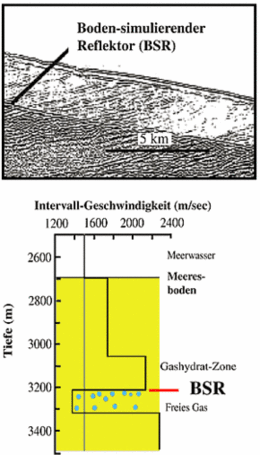Page path:
- General/Marine Geology
- Gas Hydrate Research
- Seismic Evidence
Seismic Evidence
Thomas D. Lorenson and Keith A. Kvenvolden (U.S. Geological Survey) have compiled all the gas hydrate deposits known so far. Samples of gas hydrate have been taken at approximately 20 different sites. Further occurrences have been identified by geochemical analyses, e.g. of chloride anomalies in pore waters.
During the Ocean Drilling Program various BSR horizons on the continental slopes off Peru, Chile, Costa Rica, Oregon/Washington and at Blake Ridge off North Carolina have been sampled. Although some details of the signatures are not yet fully understood, it appears to be clear that the strength and the characteristics of BSRs are determined by free gas below the gas hydrate occurrence zone. Seismic velocity is an important feature in this context as it is higher in sediment cemented by gas hydrates than in uncemented sediments. The existence of free gas below the BSR causes a further drastic decrease of seismic velocity, sometimes to levels lower than the seismic velocity of sea water (1500 m/sec). If there is no free gas below gas hydrate deposits, a BSR will not be discernable and thus it will be impossible to detect the deposit by means of conventional seismic techniques. The fact that geophysical methods sometimes fail to detect gas hydrates may indicate that the total volume of gas hydrate worldwide is still underestimated.
During the Ocean Drilling Program various BSR horizons on the continental slopes off Peru, Chile, Costa Rica, Oregon/Washington and at Blake Ridge off North Carolina have been sampled. Although some details of the signatures are not yet fully understood, it appears to be clear that the strength and the characteristics of BSRs are determined by free gas below the gas hydrate occurrence zone. Seismic velocity is an important feature in this context as it is higher in sediment cemented by gas hydrates than in uncemented sediments. The existence of free gas below the BSR causes a further drastic decrease of seismic velocity, sometimes to levels lower than the seismic velocity of sea water (1500 m/sec). If there is no free gas below gas hydrate deposits, a BSR will not be discernable and thus it will be impossible to detect the deposit by means of conventional seismic techniques. The fact that geophysical methods sometimes fail to detect gas hydrates may indicate that the total volume of gas hydrate worldwide is still underestimated.

Picture:
Seismic record from Blake Ridge, showing the presence of gas hydrates and the BSR within the sediment (above). Variations of the weak reflections above the BSR correspond to a varying gas hydrate contents in the sediment pore spaces. Below the BSR strong reflections caused by free gas in the pores are obvious. A seismic velocity model (below) shows the strong contrast of velocity in the BSR zone.
Seismic record from Blake Ridge, showing the presence of gas hydrates and the BSR within the sediment (above). Variations of the weak reflections above the BSR correspond to a varying gas hydrate contents in the sediment pore spaces. Below the BSR strong reflections caused by free gas in the pores are obvious. A seismic velocity model (below) shows the strong contrast of velocity in the BSR zone.


